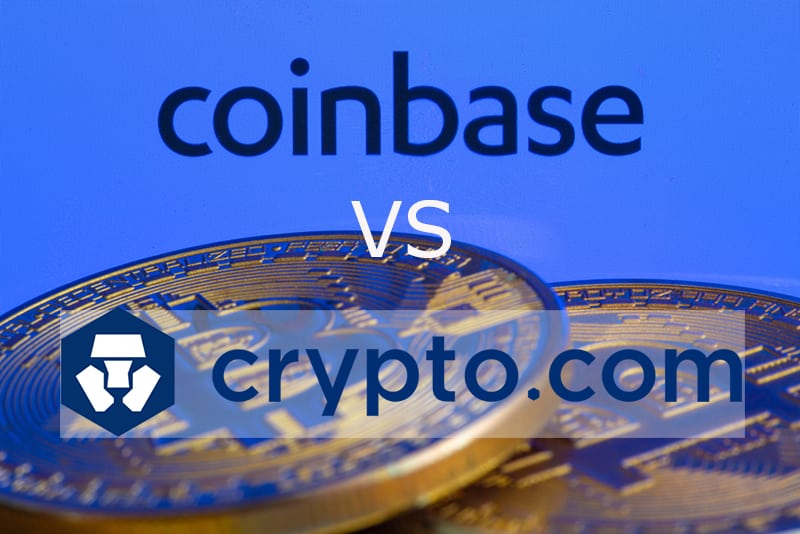Established in 2012, Coinbase is one of the oldest and most trusted cryptocurrency exchanges on the planet. According to CoinMarketCap, the US-based exchange facilitates the second-highest trading volume daily, regularly surpassing $1 billion.
However, another exchange rising in prominence over the last few years is Crypto.com, presently ranked #14 for exchanges processing the highest daily trading volume.
Crypto.com is based in Singapore and came onto the scene as ‘Monaco’ in July 2016 before rebranding to its current name in July 2018.
This exchange has been one of the fastest-growing crypto-related companies, providing a diverse range of trading, payment, and DeFi (decentralized finance) services competing with the more established players like Binance and Coinbase.
So, how do Crypto.com and Coinbase stack up against each other? Well, we’ve done thorough homework in comparing the two. So, let’s explore the pros and cons of each in this article.
Features comparison between Crypto.com and Coinbase
Before diving into the pros and cons of each service, let’s observe an overview of the main features they provide.
| Crypto.com | Coinbase | |
| Year established | 2016 | 2012 |
| Headquarters location | Singapore | United States |
| Security measures | 100% offline cold storage, two-factor authentication, bug bounty, insurance | 98% offline cold storage, two-factor authentication, bug bounty, insurance, |
| Customer service channels | 24/7 live support, email, help center | Phone, email, help center |
| Regulated? | Yes | Yes |
| Anonymity? | No | No |
| Utility token? | Yes, CRO | No |
| Type of transactions supported | Buying, selling, sending, receiving, withdrawing, exchanging, and derivatives on margin | Buying, selling, sending, receiving, withdrawing, and exchanging |
| Number of cryptocurrencies offered | 161 (according to CoinMarketCap) | 146 (according to CoinMarketCap) |
| Countries supported | 90 | 100+ |
| Wallet provided? | Yes | Yes |
| NFT support? | Yes | Yes |
| Minimum deposit | $1 | $2 |
| Deposit/withdrawal methods | Crypto, ACH, bank wire, debit/credit card | Crypto, ACH, bank wire, debit/credit card |
| Deposit/withdrawal fees | Varies by coin and method | Varies by coin and method |
| Withdrawal limits? | Yes | Yes |
| Maker-taker fees | 0.04-0.4% maker/0.1%-0.4% taker | 0-0.5% maker/0.04-0.50% taker |
| Interest-bearing accounts? | Yes, up to 14.5% APY | Yes, up to 5% APY |
| Crypto lending? | Yes, with an LTV ratio between 25-50% | Yes, with a 60% LTV ratio |
| Lending interest rates | 8-12% | 8% |
| Minimum loan amount | $100 | $100 in most countries |
| VISA card? | Yes, debit card | Yes, debit card |
Pros and cons of Crypto.com
Here are the benefits and drawbacks of Crypto.com.
Pros
- Utility token: CRO has been one of the best-performing utility tokens in the markets.
The point of a utility token is increasing liquidity within an exchange and offering incentives to clients. In CRO’s case, clients staking this coin receive several perks.
By having CRO, users get discounts on maker-taker fees, bigger staking rewards, merchant cashback offers, and better interest rates for lending.
- Better lending interest rates for staking/yield farming: You can receive up to 14.5% APY (annual percentage yield) in earnings from lending or staking. Coinbase only offers a maximum of 5% on your crypto holdings.
- Offers more types of trading: Aside from simple buying and selling of coins, you can also trade on margin with some cryptocurrencies on the platform.
Cons
- Less competitive borrowing interest rate: Coinbase charges a flat 8% in interest, while you pay between 8-12% with Crypto.com.
- No phone support: Some clients still like human contact, despite Crypto.com providing 24/7 live chat and email support.
- High barrier to entry with CRO incentives: Although this utility token provides some incentives, you need to stake at least 5000 CRO (roughly $3000 presently) to receive most of the perks.
Pros and cons of Coinbase
So, what’s good and bad about Coinbase? Let’s see.
Pros
- High trading volume: After Binance, Coinbase processes the second-largest trading volume in the markets. This makes the exchange a substantially liquid environment, minimizing the chances of slippage and other price discrepancies.
- Coinbase Earn: This is an educational program where new clients can earn a few dollars in crypto learning about different digital currencies. If one completes most of the quizzes, they could receive around $50 depending on the number of available coins.
- The competitive lending interest rate of 8%
- Fairly sizeable range of cryptocurrencies
- Users can stake various cryptocurrencies on the platform and receive up to 5% APY
Cons
- Only one collateral type for borrowing: With Coinbase, you can only use BTC to collateralize your loan, which is quite limiting. On the other hand, you have many more options with Crypto.com.
- High LTV (loan-to-value) ratio: Generally, with crypto lending, you want the highest LTV. The industry average is 50%, although a few services can go much higher. Coinbase’s 40% ratio means you can only borrow up to 40% of your collateral.
- No margin trading: In 2020, several US-based exchanges banned margin, a decision taken because of regulatory changes to this type of trading in the country.
- Slightly higher maker-taker fees: Coinbase has a reputation for pricey trades. 0.0.05% maker and 0.04-0.50% taker fees are higher than the industry average.
Final word
Overall, Crypto.com is a more experimental exchange compared to Coinbase. Because Coinbase is an American company, it has kept its offerings to a minimum since the country’s regulators aren’t yet wholly welcoming of cryptocurrencies in general.
Since Crypto.com is based in a less strict nation, it has more freedom to offer radical and riskier products, particularly those in decentralized finance. Another notable advantage with Crypto.com is marginally lower trading fees than Coinbase.
Despite being somewhat stripped-down while offering an extensive range of cryptocurrencies, Coinbase is easier to use than Crypto.com. The other benefit over Crypto.com is the educational reward promotions which they change from time to time.
Ultimately, Crypto.com edges Coinbase based on the number of features. Yet, your decision to use either exchange should boil down over which particular services are necessary to your needs.



